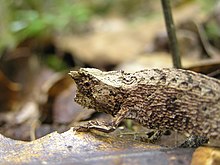
Back حرباء ورقية Arabic حرباء ورقيه ARZ Brookesia Catalan Brookesia CEB Брукезисем CV Brookesia German Brookesia Spanish Brookesia Basque Maakameleontit Finnish Brookesia French
| Brookesia | |
|---|---|

| |
| Scientific classification | |
| Domain: | Eukaryota |
| Kingdom: | Animalia |
| Phylum: | Chordata |
| Class: | Reptilia |
| Order: | Squamata |
| Suborder: | Iguania |
| Family: | Chamaeleonidae |
| Subfamily: | Brookesiinae |
| Genus: | Brookesia Gray, 1864 |
| Type species | |
| Chamaeleo superciliaris Kuhl, 1820
| |
| Diversity | |
| 31 species | |
Brookesia is a genus of chameleons, lizards in the family Chamaeleonidae. The genus is endemic to Madagascar. Member species range from small to very small in size, and are known collectively as leaf chameleons (though this common name is also used for species in the genera Rieppeleon and Rhampholeon). Brookesia includes species considered to be the world's smallest chameleons, and are also among the smallest reptiles. Members of the genus Brookesia are largely brown, and most are essentially terrestrial.
A significant percentage of the species in the genus were only identified to science within the last three decades, and a number of species that still have not received a scientific name are known to exist. Most inhabit very small ranges in areas that are difficult to access, and due to their small size and secretive nature, they have been relatively poorly studied compared to their larger relatives.
Brookesia are abundant in low-disturbance riparian zones[1] and low-disturbance rainforests. Brookesia are scarce in high-disturbance forests[2] recovering from burning. As of 2021, Brookesia nana is the most recently described new species in the subfamily Brookesiinae. B. nana is also the first chameleon known not to change colors.[citation needed]
- ^ Jenkins, Richard K.B.; Brady, Lee D.; Bisoa, Michel; Rabearivony, Jeanneney; Griffiths, Richard A. (2003). "Forest disturbance and river proximity influence chameleon abundance in Madagascar". Biological Conservation. 109 (3): 407–415. Bibcode:2003BCons.109..407J. doi:10.1016/S0006-3207(02)00166-0.
- ^ Raxworthy, Christopher J.; Nussbaum, Ronald A. (1994). "A Rainforest Survey of Amphibians, Reptiles and Small Mammals at Montagne D'Ambre, Madagascar". Biological Conservation. 69 (1): 65–73. Bibcode:1994BCons..69...65R. doi:10.1016/0006-3207(94)90329-8. hdl:2027.42/31871.
© MMXXIII Rich X Search. We shall prevail. All rights reserved. Rich X Search